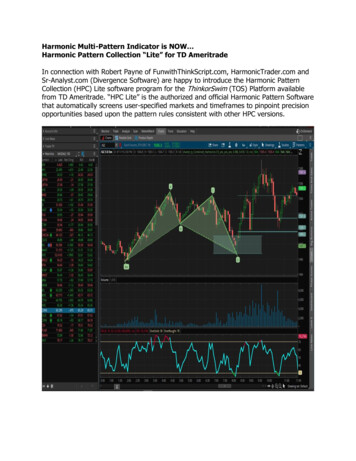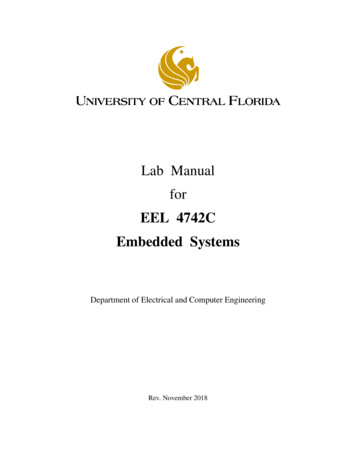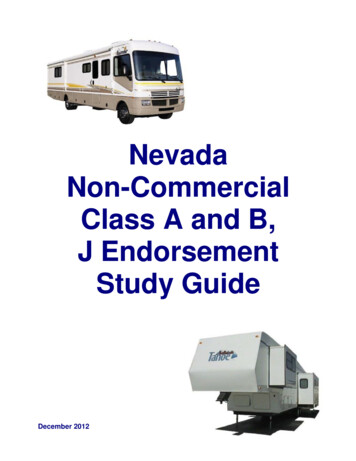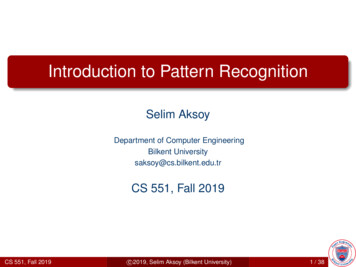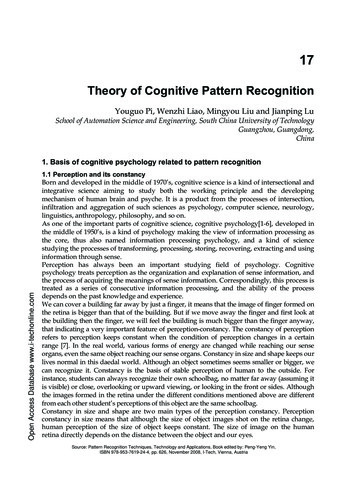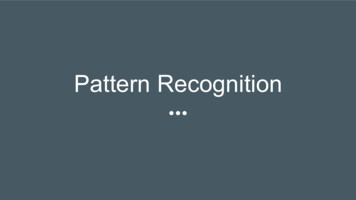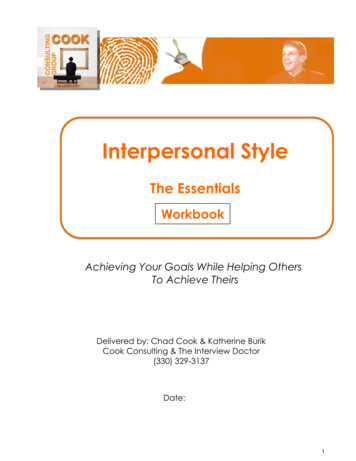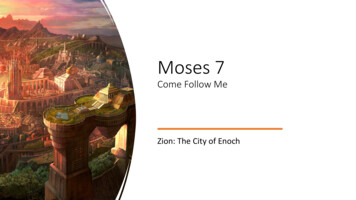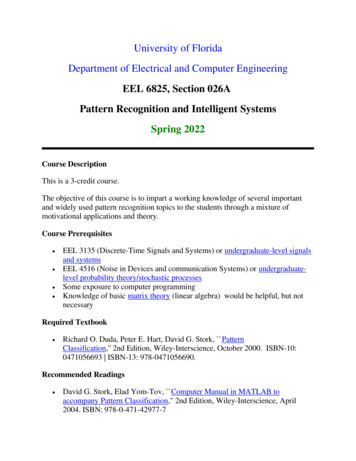
Transcription
University of FloridaDepartment of Electrical and Computer EngineeringEEL 6825, Section 026APattern Recognition and Intelligent SystemsSpring 2022Course DescriptionThis is a 3-credit course.The objective of this course is to impart a working knowledge of several importantand widely used pattern recognition topics to the students through a mixture ofmotivational applications and theory.Course Prerequisites EEL 3135 (Discrete-Time Signals and Systems) or undergraduate-level signalsand systemsEEL 4516 (Noise in Devices and communication Systems) or undergraduatelevel probability theory/stochastic processesSome exposure to computer programmingKnowledge of basic matrix theory (linear algebra) would be helpful, but notnecessaryRequired Textbook Richard O. Duda, Peter E. Hart, David G. Stork, PatternClassification,'' 2nd Edition, Wiley-Interscience, October 2000. ISBN-10:0471056693 ISBN-13: 978-0471056690.Recommended Readings David G. Stork, Elad Yom-Tov, Computer Manual in MATLAB toaccompany Pattern Classification," 2nd Edition, Wiley-Interscience, April2004. ISBN: 978-0-471-42977-7
Christopher M. Bishop, “Pattern Recognition and Machine Learning”,1st Edition, Springer, October 1, 2007. ISBN-10: 0387310738 ISBN-13: 9780387310732.Trevor Hastie, Robert Tibshirani, Jerome Friedman, "The Elements ofStatistical Learning: Data Mining, Inference, and Prediction," SecondEdition, Springer, February 9, 2009. ISBN-10: 0387848576 ISBN-13: 9780387848570.Kevin Patrick Murphy, "Machine Learning: a Probabilistic Perspective," theMIT Press, August 24, 2012. ISBN-10: 0262018020 ISBN-13: 9780262018029.Eugene Charniak, "Introduction to Deep Learning," the MIT Press, January2019. ISBN: 9780262039512 (This book is a project-based guide to the basicsof deep learning)Instructor:Dr. Dapeng WuOffice: NEB 431Email: wu@ece.ufl.eduTA:1) Heng QiaoEmail: hengqiao@ufl.edu2) Haotian JiangEmail: haotian.jiang@ufl.edu3) Xiyao MaEmail: maxiy@ufl.edu4) Tianqi LiuEmail: tianqi.liu1@ufl.eduCourse 22Meeting TimeMonday, Wednesday, Friday, period 9 (4:05 pm - 4:55 pm)
Meeting RoomNEB 100Office Hours Dr. Wu: Monday, Wednesday, period 8 (3:00 pm - 3:50 pm), and by appointmentvia email.Structure of the CourseThe course consists of lectures, 4 homework assignments, a quiz, and 1 project.This course is primarily a lecture course. I cover all important material inlectures. Since EEL 3135 and EEL 4516 are prerequisites, I assume some previousknowledge about DSP, probability theory and stochastic processes, and hence I willcover some material very quickly. Thus, depending on what and how much you recallfrom earlier study, varying amounts of reading in introductory books on DSP,probability theory and stochastic processes (other than the course textbook) may benecessary; these readings are up to the student. I will only give reading assignmentsfrom the course textbook.Attending lecture is quite important as I may cover material not available in any bookeasily accessible to you. I use Powerpoint presentation during lecture. Lecture noteswill be posted on the course website before the class. The lecture is to engage thestudents in independent thinking, critical thinking, and creative thinking, help thestudents organize the knowledge around essential concepts and fundamentalprinciples, and develop conditionalized knowledge which tells them when, where andwhy a certain method is applicable to solving the problem they encounter.I do not intend for the WWW material to be a substitute for attending lecture sinceengaging the students in active thinking, making logical connections between the oldknowledge and the new knowledge, and providing insights are the objectives of mylecture. The lecture notes are posted on the web so that you can miss an occasionallecture and still catch up, and it makes taking notes easier. To reward those whoattend regularly, there will be some lecture-based material in the exam which is notavailable via the web.The class project is described here.Course Outline
MoCA principle for AIBayesian decision theoryParametric estimation and supervised learningNonparametric methodsLinear discriminant functionsUnsupervised learning and clusteringFeature extraction and feature selectionDeep learningSupport vector machinesGraphical modelsCausal inferenceApplicationsCourse ObjectivesUpon the completion of the course, the student should be able to use the fundamental techniques for pattern recognitionunderstand the basics of statistical learning theoryacquire the basic skill of designing machine learning algorithms and systemsHandoutsPlease find handouts here.Course Policies Attendance Policy, Class Expectations, and Make-Up Policyo Excused absences must be consistent with university policies in theGraduate Catalog (https://catalog.ufl.edu/graduate/regulations) andrequire appropriate documentation. Additional information can be foundhere: https://catalog.ufl.edu/graduate/regulations/o Perfect class attendance is not required, but regular attendance isexpected.o It is the student's responsibility to independently obtain any missedmaterial (including handouts) from lecture.
During lecture, cell phones should be turned off.No late submissions of your homework solution, and projectproposal/report, are allowed unless U.F. approved reasons are suppliedand advance permission is granted by the instructor. Excused latesubmissions are consistent with university policies in the /current/regulations/info/attendance.aspx)and require appropriate documentation. Software useo All faculty, staff and student of the University are required and expected to obeythe laws and legal agreements governing software use. Failure to do so can leadto monetary damages and/or criminal penalties for the individualviolator. Because such violations are also against University policies and rules,disciplinary action will be taken as appropriate. We, the members of theUniversity of Florida community, pledge to uphold ourselves and our peers to thehighest standards of honesty and integrity. Announcements:o All students are responsible for announcements made in lecture, on thestudent access website, or via the class email list.o It is expected that you will check your email several times per week forpossible course announcements.Students Requiring Accommodationso Students with disabilities who experience learning barriers and wouldlike to request academic accommodations should connect with thedisability Resource Center by arted/. It is important for studentsto share their accommodation letter with their instructor and discuss theiraccess needs, as early as possible in the semester. University Honesty PolicyUF students are bound by The Honor Pledge which states, “We, the members ofthe University of Florida community, pledge to hold ourselves and our peers tothe highest standards of honor and integrity by abiding by the Honor Code. Onall work submitted for credit by students at the University of Florida, thefollowing pledge is either required or implied: “On my honor, I have neithergiven nor received unauthorized aid in doing this assignment.” The ConductCode code/) specifies anumber of behaviors that are in violation of this code and the possible sanctions.If you have any questions or concerns, please consult with the instructor or TAsin this class.
Students are encouraged to discuss class material in order to better understandconcepts. All homework answers must be the author's own work. However,students are encouraged to discuss homework to promote better understanding.What this means in practice is that students are welcome to discuss problems andsolution approaches, and in fact can communally work solutions at a board.However, the material handed in must be prepared starting with a clean sheet ofpaper (and the author's recollection of any solution session), but not refer to anywritten notes or existing code from other students during the writing of thesolution. In other words, writing the homework report shall be an exercise indemonstrating the student understands the materials on his/her own, whether ornot help was provided in attaining that understanding.All work submitted in this course must be your own and produced exclusivelyfor this course. The use of sources (ideas, quotations, paraphrases) must beproperly acknowledged and documented. For the copy of the UF Honor e.php. Violations will betaken seriously and are noted on student disciplinary records. If you are in doubtregarding the requirements, please consult with the instructor before youcomplete any requirement of the course.Course EvaluationStudents are expected to provide professional and respectful feedback on the quality ofinstruction in this course by completing course evaluations online via GatorEvals.Guidance on how to give feedback in a professional and respectful manner is availableat https://gatorevals.aa.ufl.edu/students/. Students will be notified when the evaluationperiod opens, and can complete evaluations through the email they receive fromGatorEvals, in their Canvas course menu under GatorEvals, or viahttps://ufl.bluera.com/ufl/. Summaries of course evaluation results are available tostudents at itment to a Safe and Inclusive Learning EnvironmentThe Herbert Wertheim College of Engineering values broad diversity within ourcommunity and is committed to individual and group empowerment, inclusion, andthe elimination of discrimination. It is expected that every person in this class willtreat one another with dignity and respect regardless of gender, sexuality, disability,age, socioeconomic status, ethnicity, race, and culture.
If you feel like your performance in class is being impacted by discrimination orharassment of any kind, please contact your instructor or any of the following: Your academic advisor or Graduate Program Coordinator Jennifer Nappo, Director of Human Resources, 352-392-0904, jpennacc@ufl.edu Curtis Taylor, Associate Dean of Student Affairs, 352-392-2177, taylor@eng.ufl.edu Toshikazu Nishida, Associate Dean of Academic Affairs, 352-392-0943,nishida@eng.ufl.eduSoftware UseAll faculty, staff, and students of the University are required and expected to obey thelaws and legal agreements governing software use. Failure to do so can lead tomonetary damages and/or criminal penalties for the individual violator. Because suchviolations are also against University policies and rules, disciplinary action will betaken as appropriate. We, the members of the University of Florida community,pledge to uphold ourselves and our peers to the highest standards of honesty andintegrity.Student PrivacyThere are federal laws protecting your privacy with regards to grades earned incourses and on individual assignments. For more information, please see:https://registrar.ufl.edu/ferpa.htmlIn-Class RecordingStudents are allowed to record video or audio of class lectures. However, the purposesfor which these recordings may be used are strictly controlled. The only allowablepurposes are (1) for personal educational use, (2) in connection with a complaint tothe university, or (3) as evidence in, or in preparation for, a criminal or civilproceeding. All other purposes are prohibited. Specifically, students may not publishrecorded lectures without the written consent of the instructor.A “class lecture” is an educational presentation intended to inform or teach enrolledstudents about a particular subject, including any instructor-led discussions that formpart of the presentation, and delivered by any instructor hired or appointed by the
University, or by a guest instructor, as part of a University of Florida course. A classlecture does not include lab sessions, student presentations, clinical presentations suchas patient history, academic exercises involving solely student participation,assessments (quizzes, tests, exams), field trips, private conversations between studentsin the class or between a student and the faculty or lecturer during a class session.Publication without permission of the instructor is prohibited. To “publish” means toshare, transmit, circulate, distribute, or provide access to a recording, regardless offormat or medium, to another person (or persons), including but not limited to anotherstudent within the same class section. Additionally, a recording, or transcript of arecording, is considered published if it is posted on or uploaded to, in whole or in part,any media platform, including but not limited to social media, book, magazine,newspaper, leaflet, or third party note/tutoring services. A student who publishes arecording without written consent may be subject to a civil cause of action institutedby a person injured by the publication and/or discipline under UF Regulation 4.040Student Honor Code and Student Conduct Code.Campus Resources:Health and WellnessCovid-19 Protocols: You are expected to wear approved face coverings at all times during class andwithin buildings even if you are vaccinated. If you are sick, stay home and self-quarantine. Please visit the UF Health Screen,Test & Protect website about next steps, retake the questionnaire and schedule yourtest for no sooner than 24 hours after your symptoms began. Please call your primarycare provider if you are ill and need immediate care or the UF Student Health CareCenter at 352-392-1161 (or email covid@shcc.ufl.edu) to be evaluated for testing andto receive further instructions about returning to campus. If you are withheld from campus by the Department of Health through Screen, Test& Protect, you are not permitted to use any on campus facilities. Students attemptingto attend campus activities when withheld from campus will be referred to the Dean ofStudents Office. UF Health Screen, Test & Protect offers guidance when you are sick, have beenexposed to someone who has tested positive or have tested positive yourself. Visit theUF Health Screen, Test & Protect website for more information.
Please continue to follow healthy habits, including best practices like frequent handwashing. Following these practices is our responsibility as Gators.U Matter, We Care:Your well-being is important to the University of Florida. The U Matter, We Careinitiative is committed to creating a culture of care on our campus by encouragingmembers of our community to look out for one another and to reach out for help if amember of our community is in need. If you or a friend is in distress, please contactumatter@ufl.edu so that the U Matter, We Care Team can reach out to the student indistress. A nighttime and weekend crisis counselor is available by phone at 352-3921575. The U Matter, We Care Team can help connect students to the many otherhelping resources available including, but not limited to, Victim Advocates, Housingstaff, and the Counseling and Wellness Center. Please remember that asking for helpis a sign of strength. In case of emergency, call 9-1-1.Counseling and WellnessCenter: http://www.counseling.ufl.edu/cwc, and 392-1575; and the University Police Department:392-1111 or 9-1-1 for emergencies.Counseling and Wellness Center: https://counseling.ufl.edu, and 392-1575; and theUniversity Police Department: 392-1111 or 9-1-1 for emergencies.Sexual Discrimination, Harassment, Assault, or ViolenceIf you or a friend has been subjected to sexual discrimination, sexual harassment,sexual assault, or violence contact the Office of Title IX Compliance, located at YonHall Room 427, 1908 Stadium Road, (352) 273-1094, title-ix@ufl.eduSexual Assault Recovery Services (SARS)Student Health Care Center, 392-1161.University Police Department at 392-1111 (or 9-1-1 for emergencies), orhttp://www.police.ufl.edu/.Academic ResourcesE-learning technical support, 352-392-4357 (select option 2) or e-mail to Learningsupport@ufl.edu. https://lss.at.ufl.edu/help.shtml.Career Resource Center, Reitz Union, 392-1601. Career assistance andcounseling. https://www.crc.ufl.edu/.Library Support, http://cms.uflib.ufl.edu/ask. Various ways to receive assistancewith respect to using the libraries or finding resources.
Teaching Center, Broward Hall, 392-2010 or 392-6420. General study skills andtutoring. https://teachingcenter.ufl.edu/.Writing Studio, 302 Tigert Hall, 846-1138. Help brainstorming, formatting, and writingpapers. https://writing.ufl.edu/writing-studio/.Student Complaints Campus: https://www.dso.ufl.edu/documents/UF Complaints policy.pdf.On-Line Students Complaints: ss.Grading:Grading:GradesPercentageDue DatesHomework30%See the course calendarProject proposal10%4pm, March 18Quiz10%April 20Project report50%4pm, April 27The project report consists of1.2.3.4.(50%) A written report for your project(25%) Computer programs that you develop for your project(10%) Powerpoint file of your presentation(15%) Your presentation/demo video on YouTubeGrading scale:Top 25% students will receive A. Average score will be at least B .More information on UF grading policy may be found ns/info/grades.aspxHomework:
Due dates of assignments are specified in the course calendar.No late submissions are allowed unless U.F. approved reasons are supplied and advancepermission is granted by the instructor.If you wish to dispute a homework grade, you must return the assignment along with asuccinct written argument within one week after the graded materials have been returnedto the class. Simple arithmetic errors in adding up grade totals are an exception, and cannormally be handled verbally on-the-spot during office hours of the TA. For all otherdisputes, the entire homework may be (non-maliciously) re-graded, which may result inincrease or decrease of points.Class Project:The class project will be done individually. Each project requires a proposal and afinal report. The final report is expected to be in the format of a conference paperplus computer programs, a Powerpoint file, and a video. On March 18, the projectproposal (up to 2 pages) is due. On April 27, the final report (up to 10 pages) is due. For detailsabout the project, please read here.Suggested topics for projects are listed here.Course calendar can be found here.Useful links Anaconda: Anaconda is the leading open data science platform powered byPython.Theano: Theano is a Python library that lets you to define, optimize, andevaluate mathematical expressions, especially ones with multi-dimensionalarrays (numpy.ndarray).
TensorFlow: TensorFlow is an open source software library for numericalcomputation using data flow graphs. Nodes in the graph represent mathematicaloperations, while the graph edges represent the multidimensional data arrays(tensors) communicated between them. The flexible architecture allows you todeploy computation to one or more CPUs or GPUs in a desktop, server, ormobile device with a single API.Keras: Keras is a minimalist, highly modular neural networks library, written inPython and capable of running on top of either TensorFlow or Theano. It wasdeveloped with a focus on enabling fast experimentation. Being able to go fromidea to result with the least possible delay is key to doing good research.PyTorch: PyTorch is a deep learning framework for fast, flexibleexperimentation.A curated list of resources dedicated to recurrent neural networksSource code in Python for handwritten digit recognition, using deep neuralnetworks: [another link]Source code in PyTorch for handwritten digit recognition, using deep neuralnetworksSource code in Python for TF-mRNN: a TensorFlow library for imagecaptioningSource code in Python for the following work on image captioning:o Oriol Vinyals, Alexander Toshev, Samy Bengio, Dumitru Erhan, Showand Tell: A Neural Image Caption Generator, CVPR 2015 ImplementationImage captioning:o Zhe Gan, et. al, Semantic Compositional Networks for VisualCaptioning, CVPR 2017 Implementation Source code in Python (Theano)o Bottom-Up and Top-Down Attention for Image Captioning and VisualQuestion Answering: source codes (Caffe) and source codes (PyTorch)Microsoft COCO datasetsVisual Question Answering:o Bottom-Up and Top-Down Attention for Image Captioning and VisualQuestion Answering: source codes (Caffe) and VQA sourcecode (PyTorch)Semantic Propositional Image Caption Evaluation (SPICE)o Source code in JAVA to calculate SPICERegion-based Convolutional Neural Networks (R-CNN)o References: Ren, Shaoqing, Kaiming He, Ross Girshick, and Jian Sun. "FasterR-CNN: Towards real-time object detection with region proposal
networks." In Advances in neural information processing systems,pp. 91-99. 2015. [pdf] Dai, Jifeng, Yi Li, Kaiming He, and Jian Sun. "R-FCN: Objectdetection via region-based fully convolutional networks." InAdvances in neural information processing systems, pp. 379-387.2016. [pdf] [source code] Huang, Jonathan, Vivek Rathod, Chen Sun, Menglong Zhu,Anoop Korattikara, Alireza Fathi, Ian Fischer et al."Speed/accuracy trade-offs for modern convolutional objectdetectors." arXiv preprint arXiv:1611.10012 (2016). [pdf] (E.g.,for Inception V3, extract features from the “Mixed 6e” layerwhose stride size is 16 pixels. Feature maps are cropped andresized to 17x17.)o Source codes: A Faster Pytorch Implementation of Faster R-CNN (PyTorch) Bottom-Up and Top-Down Attention for Image Captioning andVisual Question Answering: source codes (Caffe)Source code in Python for end-to-end training of LSTMo ImplementationBidirectional Encoder Representations from Transformers (BERT)o Implementation in TensorFlowo Implementation in PyTorchSource code in Python for sequence-to-sequence learning (language translation,chatbot)o TensorFlow seq2seq libraryo Implementation 1 on Tensorflow with separable encoder and decodero Implementation 2 on KerasVisual Storytelling Dataset (VIST)o Visual storytelling algorithms: No Metrics Are Perfect: Adversarial REward Learning for VisualStorytelling: source codes (TensorFlow)Visual Genome is a dataset, a knowledge base, an ongoing effort to connectstructured image concepts to language.MPII Movie & Description dataset for automatic video description, videosummary, video storytellingBidirectional recurrent neural networks (B-RNN):o Graves, Alan, Navdeep Jaitly, and Abdel-rahman Mohamed. "Hybridspeech recognition with deep bidirectional LSTM." IEEE Workshop onAutomatic Speech Recognition and Understanding (ASRU), 2013. [pdf]Deep reinforcement learningo UCL Course on reinforcement learning: [ppt] [video]
References: Mnih, Volodymyr, Koray Kavukcuoglu, David Silver, AlexGraves, Ioannis Antonoglou, Daan Wierstra, and MartinRiedmiller. "Playing atari with deep reinforcementlearning." arXiv preprint arXiv:1312.5602 (2013). Mnih, Volodymyr, Koray Kavukcuoglu, David Silver, Andrei A.Rusu, Joel Veness, Marc G. Bellemare, Alex Graves et al."Human-level control through deep reinforcementlearning." Nature 518, no. 7540 (2015): 529-533. [source code] How to Study Reinforcement Learningo Source codes: Implementation of Reinforcement Learning Algorithms. Python,OpenAI Gym, Tensorflow. Exercises and Solutions to accompanySutton's Book and David Silver's course. [link]Generative Adversarial Network (GAN)o References: Goodfellow, Ian, Jean Pouget-Abadie, Mehdi Mirza, Bing Xu,David Warde-Farley, Sherjil Ozair, Aaron Courville, and YoshuaBengio. "Generative adversarial nets." In Advances in neuralinformation processing systems, pp. 2672-2680. 2014. Radford, Alec, Luke Metz, and Soumith Chintala. "Unsupervisedrepresentation learning with deep convolutional generativeadversarial networks." arXiv preprint arXiv:1511.06434 (2015). Arjovsky, Martin, Soumith Chintala, and Léon Bottou."Wasserstein GAN." arXiv preprint arXiv:1701.07875 (2017).o Types of GAN1. Vanilla GAN2. Conditional GAN3. InfoGAN4. Wasserstein GAN5. Mode Regularized GAN6. Coupled GAN7. Auxiliary Classifier GAN8. Least Squares GAN9. Boundary Seeking GAN10. Energy Based GAN11. f-GAN12. Generative Adversarial Parallelization13. DiscoGAN14. Adversarial Feature Learning & Adversarially Learned Inference15. Boundary Equilibrium GANo
16. Improved Training for Wasserstein GAN17. DualGAN18. MAGAN: Margin Adaptation for GAN19. Softmax GANo Source codes: A Tensorflow Implementation of "Deep Convolutional GenerativeAdversarial Networks": python code Collection of generative models, e.g. GAN, VAE in Pytorch andTensorflow: python codeSequential Generative Adversarial Network (GAN)o References: Yu, Lantao, Weinan Zhang, Jun Wang, and Yong Yu. "SeqGAN:Sequence Generative Adversarial Nets with Policy Gradient."In AAAI, pp. 2852-2858. 2017. Mogren, Olof. "C-RNN-GAN: Continuous recurrent neuralnetworks with adversarial training." arXiv preprintarXiv:1611.09904 (2016). Im, Daniel Jiwoong, Chris Dongjoo Kim, Hui Jiang, and RolandMemisevic. "Generating images with recurrent adversarialnetworks." arXiv preprint arXiv:1602.05110 (2016). Press, Ofir, Amir Bar, Ben Bogin, Jonathan Berant, and LiorWolf. "Language Generation with Recurrent GenerativeAdversarial Networks without Pre-training." arXiv preprintarXiv:1706.01399 (2017).o Source codes: Implementation of C-RNN-GAN Tensorflow Implementation of GAN modeling for sequential dataStanford NLP Parser: A natural language parser is a program that works out thegrammatical structure of sentences.Performance metrics for a natural language parserPrecision and recallmAP (mean Average Precision) for Object DetectionQuestion answeringo References: Seo, Minjoon, Aniruddha Kembhavi, Ali Farhadi, and HannanehHajishirzi. "Bidirectional attention flow for machinecomprehension." arXiv preprint arXiv:1611.01603 (2016).o Source codes: Bi-Directional Attention Flow (BIDAF)o Question answering datasets: Stanford Question Answering Dataset (SQuAD)
NewsQAMS MARCOThe General Language Understanding Evaluation (GLUE) benchmark is acollection of resources for training, evaluating, and analyzing natural languageunderstanding systems.Semantic Textual Similarity (STS) benchmark evaluation datasetAutomatic text understanding and reasoning:o Facebook bAbI projecto Facebook dataseto Python codeNLTK sentiment analysis toolOpinion Lexicon (dictionary of sentiment words): Positive and NegativeHuman activity recognitiono HMDB: a large human motion database Action recognition algorithmso UCF101: Action Recognition Data Set Activity recognition algorithmsCoronavirus datasetAI City ChallengeBatch Normalization and Weight Decay NotesA powerful and flexible machine learning platform for drug discoveryMATLAB TutorialMATLAB CentralMatlab Primer, Matlab Manuals, Image Processing ToolboxMatlab implementation of image/video compression algorithmsIntroduction to Matarix Algebra (free book by Autar K Kaw, Professor,University of South Florida).Matrix Reference ManualHIPR2: a WWW-based Image Processing Teaching Materials with JLearning by simulationsOpenCVOpenGLA Recipe for Training Neural Networks (by Andrej Karpathy)Download the following free (open source) program to record video withscreencapture: d CNadwsW66wCFSVjTAodbjzTSg Software:
Virtual Dub: VirtualDub is a video capture/processing utility for 32-bitWindows platforms (95/98/ME/NT4/2000/XP), licensed under the GNUGeneral Public License (GPL).XnView: is an efficient multimedia viewer, browser and converter.ImageJ: Read and write GIF, JPEG, and ASCII. Read BMP, DICOM, andFITS. [Open Source, Public Domain]Open source for image processingtasks: d courses in other institutions: Stanford University CS221: Artificial Intelligence: Principles and Techniques:[video]Stanford University CS224n: Natural Language Processing with DeepLearning: [video]Stanford University CS229 - Machine Learning: notes and video can be foundon this webStanford University CS230 Deep Learning: [ppt] [video]Stanford University CS231n: Convolutional Neural Networks for VisualRecognition: [ppt] [video]UCL Course on reinforcement learning: [ppt] [video]RWTH Aachen University Implementation of Heuristic Algorithms for BoardGamesMila - Quebec AI Institute Introduction to Causal InferenceUC Berkeley Foundations of Deep Reinforcement LearningDeepMind Reinforcement Learning Lecture SeriesJOURNALSElsevier Computer Vision and Image UnderstandingJournal of Visual Communication and Image RepresentationData & Knowledge EngineeringImage and Vision ComputingPattern RecognitionPattern Recognition Letters
IEEE IEEE Transactions on Circuits and Systems for Video TechnologyIEEE Transactions on MultimediaIEEE Transactions on Image ProcessingIEEE Transactions on Medical ImagingIEEE Transactions on PAMIComputer Vision Computer Vision Homepage at CMUAnnotated Computer Vision Bibliography from USC IRISCVonline: The Evolving, Distributed, Non-Proprietary, On-Line Compendiumof Computer Vision3-D for EveryoneRed-blue glasses or anaglyph for 3Dviewing: http://www.best3dglasses.com/anaglyph.htmlShutter glasses for 3D viewing: http://www.stereo3d.com/shutter.htm3D cameras: http://www.ptgrey.com/index.asp3D photos at http://www.jessemazer.com/3Dphotos.html3D video sequences can be downloadedat: sualMediaGroup/3DVideoDownload/
EEL 4516 (Noise in Devices and communication Systems) or undergraduate-level probability theory/stochastic processes Some exposure to computer programming Knowledge of basic matrix theory (linear algebra) would be helpful, but not necessary Required Textbook Richard O. Duda, Peter E. Hart, David G. Stork, Pattern Classification,'' 2nd Edition .

